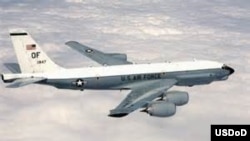WASHINGTON —
A Russian fighter jet flew within 100 feet of the nose of a U.S. military spy plane in late April north of Japan, triggering private U.S. protests to Moscow just as East-West tensions soared over the crisis in the Ukraine, the Pentagon said.
The incident took place during the afternoon of April 23, when a Russian Su-27 Flanker approached the U.S. Air Force RC-135U aircraft flying on a routine mission in international airspace over the Sea of Okhotsk, officials said.
Col. Steve Warren, a Pentagon spokesman, said there was no radio communication between the aircraft but that the Russian jet turned as it approached the U.S. plane to expose its belly.
There was no radio communication, making it "difficult to know the pilot's reasoning," Warren told reporters Tuesday. "But the effect was that the personnel on the [American plane] were able to see that the flanker was armed."
Warren added that he was not aware of any close encounters since then and that the U.S. would continue to fly its usual missions in the area.
On April 12, a Russian fighter jet made a dozen close-range passes near the Navy warship USS Donald Cook in international waters of the Black Sea.
U.S. Defense Secretary Chuck Hagel and Gen. Martin Dempsey, chairman of the U.S. military's Joint Chiefs of Staff, privately expressed their concerns about both incidents to Moscow instead of discussing the matter publicly at the time, Warren said.
Russia's embassy in Washington did not immediately respond Wednesday to a request for comment about the fly-by incident.
VOA Pentagon correspondent Jeff Seldin contributed to this report.
The incident took place during the afternoon of April 23, when a Russian Su-27 Flanker approached the U.S. Air Force RC-135U aircraft flying on a routine mission in international airspace over the Sea of Okhotsk, officials said.
Col. Steve Warren, a Pentagon spokesman, said there was no radio communication between the aircraft but that the Russian jet turned as it approached the U.S. plane to expose its belly.
There was no radio communication, making it "difficult to know the pilot's reasoning," Warren told reporters Tuesday. "But the effect was that the personnel on the [American plane] were able to see that the flanker was armed."
Warren added that he was not aware of any close encounters since then and that the U.S. would continue to fly its usual missions in the area.
On April 12, a Russian fighter jet made a dozen close-range passes near the Navy warship USS Donald Cook in international waters of the Black Sea.
U.S. Defense Secretary Chuck Hagel and Gen. Martin Dempsey, chairman of the U.S. military's Joint Chiefs of Staff, privately expressed their concerns about both incidents to Moscow instead of discussing the matter publicly at the time, Warren said.
Russia's embassy in Washington did not immediately respond Wednesday to a request for comment about the fly-by incident.
VOA Pentagon correspondent Jeff Seldin contributed to this report.








